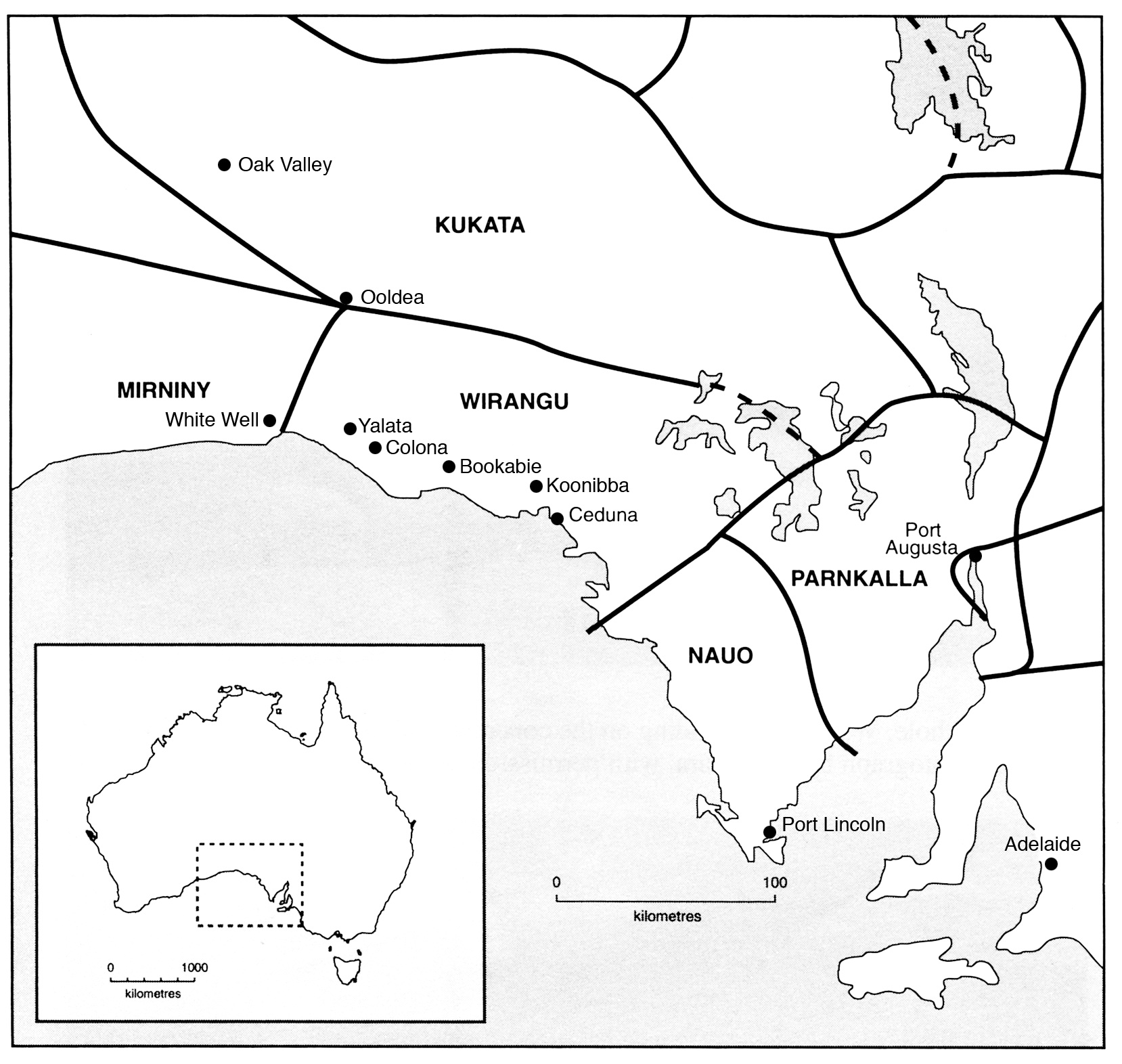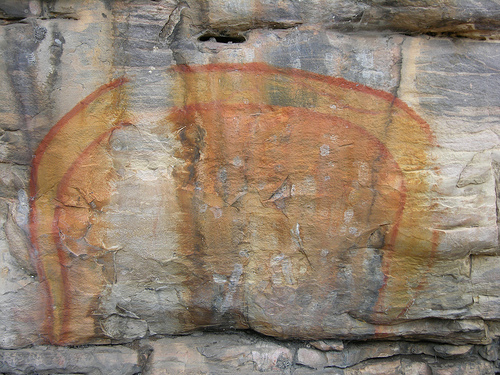|
Wirangu People
The Wirangu are an Aboriginal Australian people of the Western coastal region of South Australia. Name Daisy Bates stated that the Wirangu ethnonym was composed of two words: ''wira'' (cloud) and ''wonga'' (speech). Language Wirangu is usually classified as genetically related to the Thura-Yura language family. Early ethnographers, such as R. H. Mathews stated that the Barngarla, Nauo and Wirangu peoples were "practically the same people in language and customs". Country In Norman Tindale's estimation, the Wirangu were assigned an original tribal land extending over , embracing the coastal area between Head of Bight, Cape Blanche and Streaky Bay, with an inland extension running north to places like Ooldea, Kokatha, and Kondoolka. Mythology In ancestral times a large mother snake travelled down from the west to ''Juldi'kapi''. From there it was followed by two men (the ''Wati Kutjara'') who wished to kill it. They chased the snake south-east to Pedinga water-hole ('' ... [...More Info...] [...Related Items...] OR: [Wikipedia] [Google] [Baidu] |
Wirangu Map
{{dab ...
Wirangu may be, *Wirangu people *Wirangu language The Wirangu language, also written Wirrongu, Wirrung, Wirrunga, and Wirangga, and also known by other exonyms, is a moribund Australian Aboriginal language traditionally spoken by the Wirangu people, living on the west coast of South Australia ... [...More Info...] [...Related Items...] OR: [Wikipedia] [Google] [Baidu] |
Rainbow Serpent
The Rainbow Serpent or Rainbow Snake is a common deity often seen as the creator God, known by numerous names in different Australian Aboriginal languages by the many different Aboriginal peoples. It is a common motif in the art and religion of many Aboriginal Australian peoples. Much like the archetypal mother goddess, the Rainbow Serpent creates land and diversity for the Aboriginal people, but when disturbed can bring great chaos. There are many names and stories associated with the serpent, all of which communicate the significance and power of this being within Aboriginal mythology, which includes the worldview commonly referred to as The Dreaming. The serpent is viewed as a giver of life through its association with water, but can be a destructive force if angry. The Rainbow Serpent is one of the most common and well-known Aboriginal stories and is of great importance to Aboriginal society. Not all of the myths in this family describe the ancestral being as a snake. O ... [...More Info...] [...Related Items...] OR: [Wikipedia] [Google] [Baidu] |
Proceedings Of The American Philosophical Society
''Proceedings of the American Philosophical Society'' is a quarterly journal published by the American Philosophical Society since 1838. The journal contains papers which have been read at meetings of the American Philosophical Society each April and November, independent essays sent to the APS by outside scholars, and biographical memoirs of APS Members. References External links * Proceedings of the American Philosophical Society Biodiversity Heritage Library The Biodiversity Heritage Library (BHL) is the world’s largest open access digital library for biodiversity literature and archives. BHL operates as worldwide consortiumof natural history, botanical, research, and national libraries working toge ... * {{HathiTrust Catalog 1838 establishments in the United States Academic journals published by learned and professional societies Publications established in 1838 Quarterly journals ... [...More Info...] [...Related Items...] OR: [Wikipedia] [Google] [Baidu] |
Macmillan Publishers
Macmillan Publishers (occasionally known as the Macmillan Group; formally Macmillan Publishers Ltd and Macmillan Publishing Group, LLC) is a British publishing company traditionally considered to be one of the 'Big Five' English language publishers. Founded in London in 1843 by Scottish brothers Daniel and Alexander MacMillan, the firm would soon establish itself as a leading publisher in Britain. It published two of the best-known works of Victorian era children’s literature, Lewis Carroll's ''Alice's Adventures in Wonderland'' (1865) and Rudyard Kipling's ''The Jungle Book'' (1894). Former Prime Minister of the United Kingdom, Harold Macmillan, grandson of co-founder Daniel, was chairman of the company from 1964 until his death in December 1986. Since 1999, Macmillan has been a wholly owned subsidiary of Holtzbrinck Publishing Group with offices in 41 countries worldwide and operations in more than thirty others. History Macmillan was founded in London in 1843 by Daniel ... [...More Info...] [...Related Items...] OR: [Wikipedia] [Google] [Baidu] |
Pacific Linguistics
Pacific Linguistics was established in 1963 as a non-profit publisher at the Australian National University, Canberra, publishing linguistic books (such as grammars and dictionaries) on the languages of Oceania, the Pacific, Australia, Indonesia, Malaysia, the Philippines, Southeast Asia, South Asia, and East Asia. Since 2012, Pacific Linguistics has been published by Walter de Gruyter. Managing editors Stephen Wurm was the founding editor. Tom Dutton was the managing editor of Pacific Linguistics from 1987 to 1996.Pawley, A. "Tom Dutton: linguist". In Pawley, A., Ross, M. and Tryon, D. editors, ''The boy from Bundaberg: Studies in Melanesian linguistics in honour of Tom Dutton''. PL-514:1-12. Pacific Linguistics, The Australian National University, 2001. Other former managing editors are Malcolm Ross, Darrell Tryon, John Bowden, and Paul Sidwel. The current managing editor is Alexander Adelaar. [...More Info...] [...Related Items...] OR: [Wikipedia] [Google] [Baidu] |
Oceania (journal)
''Oceania'' is a triannual peer-reviewed academic journal that was established in 1930. It covers social and cultural anthropology of the peoples of Oceania, including Australia, Melanesia, Polynesia, Micronesia, and Southeast Asia. The journal publishes research papers as well as review articles, correspondence, and shorter comments. Occasionally, a special issue is devoted to a single topic, comprising thematically connected collections of papers prepared by a guest editor. The journal is published by Wiley-Blackwell and the editors-in-chief are Jadran Mimica (University of Sydney) and Sally Babidge (University of Queensland). Past editors include Alfred Radcliffe-Brown, Adolphus Peter Elkin, Raymond Firth Sir Raymond William Firth (25 March 1901 – 22 February 2002) was an ethnologist from New Zealand. As a result of Firth's ethnographic work, actual behaviour of societies (social organization) is separated from the idealized rules of behaviou ... and Nancy Williams. ... [...More Info...] [...Related Items...] OR: [Wikipedia] [Google] [Baidu] |
Royal Society Of South Australia
The Royal Society of South Australia (RSSA) is a learned society whose interest is in science, particularly, but not only, of South Australia. The major aim of the society is the promotion and diffusion of scientific knowledge, particularly in relation to natural sciences. The society was originally the Adelaide Philosophical Society, founded on 10 January 1853. The title "Royal" was granted by Queen Victoria in October 1880 and the society changed its name to its present name at this time. It was incorporated in 1883. It also operates under the banner Science South Australia. History The origins of the Royal Society are related to the South Australian Literary and Scientific Association, founded in August 1834, before the colonisation of South Australia, and whose book collection eventually formed the kernel of the State Library of South Australia. The Society had its origins in a meeting at the Stephens Place home of J. L. Young (founder of the Adelaide Educational Institut ... [...More Info...] [...Related Items...] OR: [Wikipedia] [Google] [Baidu] |
Australian Institute Of Aboriginal And Torres Strait Islander Studies
The Australian Institute of Aboriginal and Torres Strait Islander Studies (AIATSIS), established as the Australian Institute of Aboriginal Studies (AIAS) in 1964, is an independent Australian Government statutory authority. It is a collecting, publishing and research institute and is considered to be Australia's premier resource for information about the cultures and societies of Aboriginal and Torres Strait Islander peoples. The institute is a leader in ethical research and the handling of culturally sensitive material'Aboriginal and Torres Strait Islander Library, Information and Resource Network (ATSILIRN) Protocols for Libraries, Archives and Information Services', http://atsilirn.aiatsis.gov.au/protocols.php, retrieved 12 March 2015‘'AIATSIS Collection Development Policy 2013 – 2016'’, AIATSIS website, http://aiatsis.gov.au/sites/default/files/docs/about-us/collection-development-policy.pdf, retrieved 12 March 2015 and holds in its collections many unique and irrepla ... [...More Info...] [...Related Items...] OR: [Wikipedia] [Google] [Baidu] |
Government Of South Australia
The Government of South Australia, also referred to as the South Australian Government, SA Government or more formally, His Majesty’s Government, is the Australian state democratic administrative authority of South Australia. It is modelled on the Westminster system of government, which is governed by an elected parliament. History Until 1857, the Province of South Australia was ruled by a Governor responsible to the British Crown. The Government of South Australia was formed in 1857, as prescribed in its Constitution created by the Constitution Act 1856 (an act of parliament of the then United Kingdom of Great Britain and Ireland under Queen Victoria), which created South Australia as a self-governing colony rather than being a province governed from Britain. Since the federation of Australia in 1901, South Australia has been a state of the Commonwealth of Australia, which is a constitutional monarchy, and the Constitution of Australia regulates the state of South A ... [...More Info...] [...Related Items...] OR: [Wikipedia] [Google] [Baidu] |
Ngalia (Western Desert)
The Ngalia, or Ngalea, are an Aboriginal Australian people of the Western Desert cultural bloc resident in land extending from Western Australia to the west of South Australia. They are not to be confused with the Ngalia of the Northern Territory. Country The Ngalia's traditional lands are around the salt lake areas, such as the Serpentine Lakes in the Great Victoria Desert, northwest of Ooldea, South Australia, in what is now the Mamungari Conservation Park. Norman Tindale estimated their tribal lands as covering an extension of some . Language The Ngalia language, also known as Ooldean, is a dialect of the Western Desert language. Alternative names * ''Nangga'' ('men' in the sense that they had undergone circumcision) * ''Nanggaranggu'' * ''Nanggarangku'' (Pitjantjatjara exonym An endonym (from Greek: , 'inner' + , 'name'; also known as autonym) is a common, ''native'' name for a geographical place, group of people, individual person, language or dialect, meani ... [...More Info...] [...Related Items...] OR: [Wikipedia] [Google] [Baidu] |
Yankuntjatjarra
The Yankunytjatjara people, also written Yankuntjatjarra, Jangkundjara, and other variants, are an Aboriginal Australian people of the state of South Australia. Language Yankunytjatjara is a Western Desert language belonging to the Wati language family of the Pama-Nyungan languages. Country According to the estimation of Norman Tindale, the Yankunytjatjara's tribal lands covered approximately . These lands took in the areas of the Musgrave Ranges, with their eastern frontier around the Everard Ranges. Social organisation Yankunytjatjara kinship terminology shares many common terms with the words for kinship in the Pintupi and Pitjantjatjara dialects. Alternative names * ''Alinjera''. ('north') * ''Ankundjara'' * ''Everard Range Tribe'' * ''Jangkundjadjara'' * ''Jangundjara, Jankundjadjara, Jankunzazara'', ''Jankuntjatjara, Jankuntjatara, Jankundjindjara''. * ''Kaltjilandjara''. (a Pitjantjatjara exonym, but referring to the most southwestern of the Yankuntjatjarra horde ... [...More Info...] [...Related Items...] OR: [Wikipedia] [Google] [Baidu] |
Exonym
An endonym (from Greek: , 'inner' + , 'name'; also known as autonym) is a common, ''native'' name for a geographical place, group of people, individual person, language or dialect, meaning that it is used inside that particular place, group, or linguistic community in question; it is their self-designated name for themselves, their homeland, or their language. An exonym (from Greek: , 'outer' + , 'name'; also known as xenonym) is an established, ''non-native'' name for a geographical place, group of people, individual person, language or dialect, meaning that it is used only outside that particular place, group, or linguistic community. Exonyms exist not only for historico-geographical reasons but also in consideration of difficulties when pronouncing foreign words. For instance, is the endonym for the country that is also known by the exonym ''Germany'' in English, in Spanish and in French. Naming and etymology The terms ''autonym'', ''endonym'', ''exonym'' and ' ... [...More Info...] [...Related Items...] OR: [Wikipedia] [Google] [Baidu] |



.png)